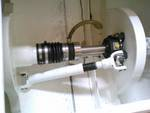Victoriana
Member
- Joined
- Mar 10, 2014
- Messages
- 24
- Location
- canada
- Vessel Name
- Victoriana
- Vessel Make
- Universal 36' Tri-Cabin
I had Victoriana hauled out for new bottom paint and to have the stuffing box packing replaced. When the yard was doing the replacement of the packing the water line fitting into the top of the stuffing box sheared off. Of course this happens on a Friday and there is no one useful around on the weekend 
My current plan is to clean up the threads in the stuffing box and see if there is anything left on it; if there is screw in a new fitting. I'm just not sure what I will do if there isn't any thread left.
Does anyone have any other suggestions or fixes?
Just out of curiosity what has your experiences been with just replacing the stuffing box with a new one or switching over to a dripless setup.
(cost, effort, benefit)
Thanks

My current plan is to clean up the threads in the stuffing box and see if there is anything left on it; if there is screw in a new fitting. I'm just not sure what I will do if there isn't any thread left.
Does anyone have any other suggestions or fixes?
Just out of curiosity what has your experiences been with just replacing the stuffing box with a new one or switching over to a dripless setup.
(cost, effort, benefit)
Thanks

